Research on Public Environmental Perception of Emotion, Taking Haze as an Example
Abstract
1. Introduction
2. Methods and Related Work
- (1)
- Construction of an environmental emotion perception model. Based on the current research background of social perception computing and deep learning, an environmental emotion perception model of the public after being affected by fog and hazy weather is constructed.
- (2)
- Acquisition of perceptual data. Use web crawler technology to obtain Weibo comment data about haze from Weibo users from 1 January 2018 to 31 December 2018 on the Weibo platform as the data source of this study.
- (3)
- Data preprocessing. Preprocess the crawled Weibo comment data, including advertisement removal, garbled information and special symbol removal, low-frequency words and stop words removal, redundant information processing, etc.
- (4)
- Annotation of emotional polarity. It is necessary to manually label the emotion polarity of each piece of Weibo comment data in some of the data, to produce a training set used to train the model and a test set used to verify the model.
- (5)
- Extraction of label data features. We need to segment the data and then vectorize the words. Prepare for data entry of the model.
- (6)
- Construction of an environmental perception of emotion classification model. Use deep learning to construct a classification model and continuously adjust the model parameters, then compare the model with the traditional machine learning classification model so that the model can achieve the classification accuracy required by the experiment.
- (7)
- Analysis and research on the environmental perception of emotions. Using the trained model, the comment data that have not been manually annotated are annotated with emotional polarity, combined with the time series analysis of public sentiment changes in the sentiment perception of haze.
3. Results Analysis
3.1. Data Sources
3.2. Data Analysis
3.2.1. Classification Analysis of the Environmental Perception of Emotion Polarity
3.2.2. Classification Analysis of Environmental
3.2.3. Application Analysis of Environmental Perception of Emotion Model
4. Conclusions
5. Discussion
Author Contributions
Funding
Institutional Review Board Statement
Informed Consent Statement
Data Availability Statement
Conflicts of Interest
References
- Ebenstein, A.; Fan, M.Y.; Greenstone, M.; He, G.; Zhou, M. Evidence on the impact of sustained exposure to air pollution on life expectancy from China’s huai river policy. Proc. Natl. Acad. Sci. USA 2013, 110, 12936–12941. [Google Scholar] [CrossRef]
- Saarinen, R. An introduction to behavioural geographyby john r. gold. Geogr. Rev. 1981, 71, 486–488. [Google Scholar] [CrossRef]
- Burneett, K.P. Behavioural Geography and Philosophy of Mind. In Golledge R G and Rushton G. Spatial Choice and Spatial Behavior; Ohilo State University Press: Columbus, GA, USA, 1976; pp. 23–50. [Google Scholar]
- Peng, J.; Zhou, S. Environmental perception an awareness building of Beijing citizens—A case study of nansha river. Hum. Geogr. 2001, 16, 21–25. [Google Scholar] [CrossRef]
- Lazer, D.; Pentland, A. Computional social science. Science 2009, 323, 721–723. [Google Scholar] [CrossRef] [PubMed]
- Mitchell, T.M. Cmputer science. Mining our reality. Science 2009, 326, 1644–1645. [Google Scholar] [CrossRef] [PubMed][Green Version]
- Zhang, C. Sentiment Tendency Analysis in Chinese Micro Blog. J. Taiyuan Norm. Univ. 2017, 16, 73–77. [Google Scholar]
- Wang, Z. Event Extraction and Sentiment Analysis on Mircoblog. Ph.D. Thesis, Shanghai Jiao Tong University, Shanghai, China, 2013. [Google Scholar]
- Zhang, H.; Wang, D.; Xu, H.; Sun, S. Sentiment Classification of Micro-blog Public Opinion Based on Convolution Neural Network. J. China Soc. Sci. Inf. 2018, 37, 47–54. [Google Scholar] [CrossRef]
- Subasic, P.; Huettner, A. Affect analysis of text using fuzzy semantic typing. IEEE Trans. Fuzzy Syst. 2001, 9, 483–496. [Google Scholar] [CrossRef]
- Kobayashi, N.; Inui, K.; Matsumoto, Y.; Tateishi, K.; Fukushima, T. Collecting Evaluative Expressions for Opinion Extraction. In International Conference on Natural Language Processing; Springer: Berlin/Heidelberg, Germany, 2005; Volume 12, pp. 596–605. [Google Scholar]
- Medhat, W.; Hassan, A.; Korashy, H. Sentiment analysis algorithms and applications: A survey. Ain Shams Eng. J. 2014, 5, 1093–1113. [Google Scholar] [CrossRef]
- Chen, L.; Guan, Z.; He, J.; Peng, J. A Survey on Sentiment Classification. J. Comput. Res. Dev. 2017, 54, 1150–1170. [Google Scholar] [CrossRef]
- Sindhwani, P.V. Document-word co-regularization for semi-supervised sentiment analysis. In 2008 Eighth IEEE International Conference on Data Mining; IEEE Computer Society: Pisa, Italy, 2008; pp. 1025–1030. [Google Scholar] [CrossRef]
- Pang, B.; Lee, L. Opinion mining and sentiment analysis. Found. Trends Inf. Retr. 2008, 2, 1–135. [Google Scholar] [CrossRef]
- Chen, Y.H.; Krishna, T.; Emer, J.S.; Sze, V. Eyeriss: An energy-efficient reconfigurable accelerator for deep convolutional neural networks. IEEE J. Solid-State Circuits 2016, 52, 127–138. [Google Scholar] [CrossRef]
- Lecun, Y.; Bottou, L. Gradient-based learning applied to document recognition. Proc. IEEE 1998, 86, 2278–2324. [Google Scholar] [CrossRef]
- Fukushima, K.; Miyake, S.; Ito, T. Neocognitron: A Self-Organizing Neural Network Model for a Mechanism of Visual Pattern Recognition. IEEE Trans. Syst. Man Cybern. 1970, SMC-13, 826–834. [Google Scholar] [CrossRef]
- Kim, Y. Convolutional neural networks for sentence classification. arXiv 2014, arXiv:1309.4168. [Google Scholar] [CrossRef]
- Guo, D.; Liu, X.; Zheng, Q. Internet Short-text Classification Method Based on CNNs. Comput. Mod. 2017, 4, 78–81. [Google Scholar] [CrossRef]
- Feng, D.; Lin, Z.; Fu, P.; Wang, W. Chinese micro-blog emotion classification based on CNN. Comput. Appl. Softw. 2017, 34, 157–164. [Google Scholar] [CrossRef]
- Kalchbrenner, N.; Grefenstette, E.; Blunsom, P. A Convolutional Neural Network for Modelling Sentences. Proc. 52nd Annu. Meet. Assoc. Comput. Linguist. 2014, 655–665. [Google Scholar]
- Poria, S.; Cambria, E.; Gelbukh, A. Aspect extraction for opinion mining with a deep convolutional neural network. Knowl.-Based Syst. 2016, 108, 42–49. [Google Scholar] [CrossRef]
- Lecum, Y.; Bengio, Y.; Hinton, G. Deep learning. Nature 2015, 521, 436. [Google Scholar] [CrossRef] [PubMed]
- Hu, B.; Tang, B.; Chen, Q.; Kang, L. A novel word embedding learning model using the dissociation between nouns verbs. Neurocomputing 2016, 171, 1108–1117. [Google Scholar] [CrossRef]
- Zhou, G.; Huang, J. Modeling and learning distributed word representation with metadata for question retrieval. IEEE Trans. Knowl. Data Eng. 2017, 29, 1226–1239. [Google Scholar] [CrossRef]
- Zhen, Y. Research on Chinese Text Sentiment Classification Method Based of Deep Learning. Ph.D. Thesis, College of Computer Science of Chongqing University, Chongqing, China, April 2018. Available online: http://cdmd.cnki.com.cn/Article/CDMD-10611-1018853238.htm (accessed on 10 November 2021).
- O’Connor, P.; Comi, G.; Freedman, M.S.; Miller, A.E.; Kappos, L.; Bouchard, J.P.; Lebrun-Frenay, C.; Mares, J.; Benamor, M.; Thangavelu, K.; et al. Long-term safety and efficacy of teriflunomide: Nine-year follow-up of the randomized TEMSO study. Neurology 2016, 86, 920–930. [Google Scholar] [CrossRef]
- Lu, Z.; Mao, H.; Wang, H. Research on the short-text classification based on convolutional neural networks. Wuxian Hulian Keji 2019, 16, 23–25. [Google Scholar] [CrossRef]
- Tan, H.; Lee, L.; Tang, J.; Zhou, M.; Li, P. User-level sentiment analysis incorporating social networks. Knowl. Discov. Data Min. 2011, 1397–1405. [Google Scholar] [CrossRef]
- Srivastava, N.; Hinton, G.; Krizhevsky, A.; Sutskever, I.; Salakhutdinov, R. Dropout: A simple way to prevent neural networks from overfitting. J. Mach. Learn. Res. 2014, 15, 1929–1958. [Google Scholar]
- Sutton, R.; Barto, A. Reinforcement Learning: An Introduction; MIT Press: Cambridge, MA, USA, 1998. [Google Scholar]
- Gerhardt, L. Pattern recognition and machine learning. IEEE Trans. Autom. Control 2003, 19, 461–462. [Google Scholar] [CrossRef]
- Sun, F.; Gao, L. Performance Evaluation Metric for Text Classifiers. Comput. Eng. 2004, 30, 107–109. [Google Scholar] [CrossRef]
- Feng, G. Review of Performance Evaluation of Text Classification. J. Intell. 2011, 8, 66–70. [Google Scholar] [CrossRef]
- Tripathy, A.; Agrawal, A.; Rath, S.K. Classification of sentiment reviews using n-gram machine learning approach. Expert Syst. Appl. 2016, 57, 117–126. [Google Scholar] [CrossRef]
- Tripathy, A.; Rath, S.K. Classification of sentiment of reviews using supervised machine learning techniques. Int. J. Rough Sets Data Anal. 2017, 4, 56–74. [Google Scholar] [CrossRef]
- Liu, Y.; Bi, J.W.; Fan, Z.P. Multi-class sentiment classification:The experimental comparisons of feature selection and machine learning algorithms. Expert Syst. Appl. 2017, 80, 323–339. [Google Scholar] [CrossRef]
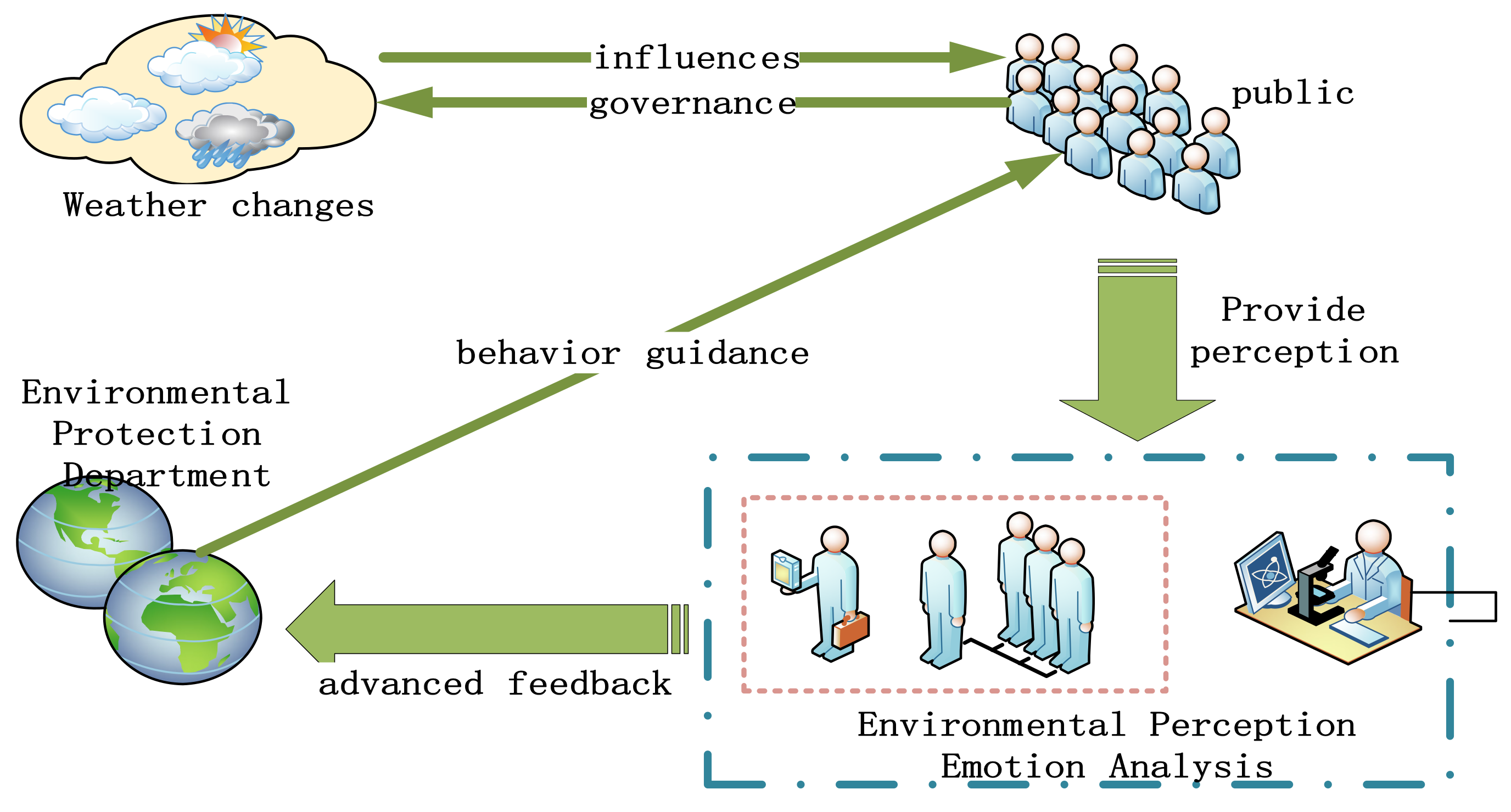
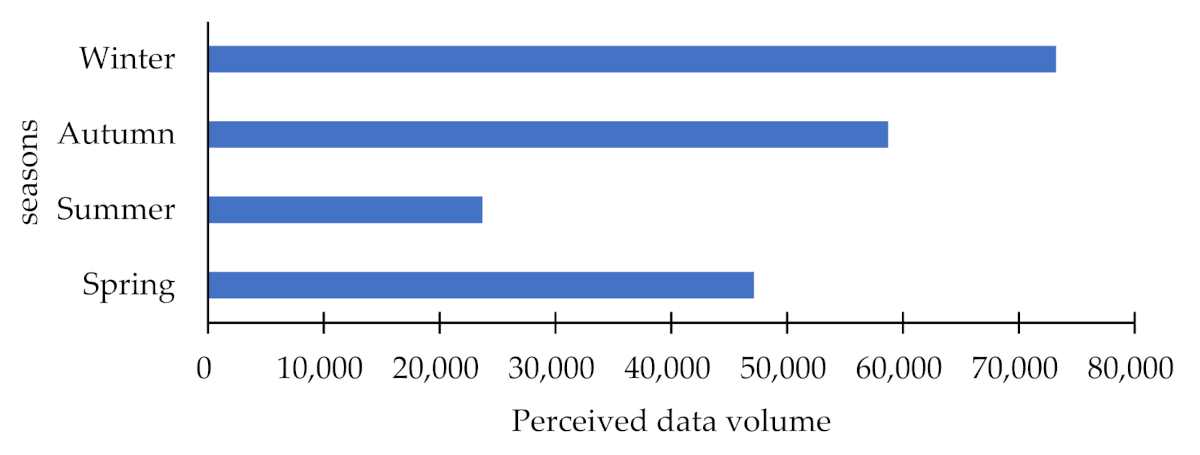
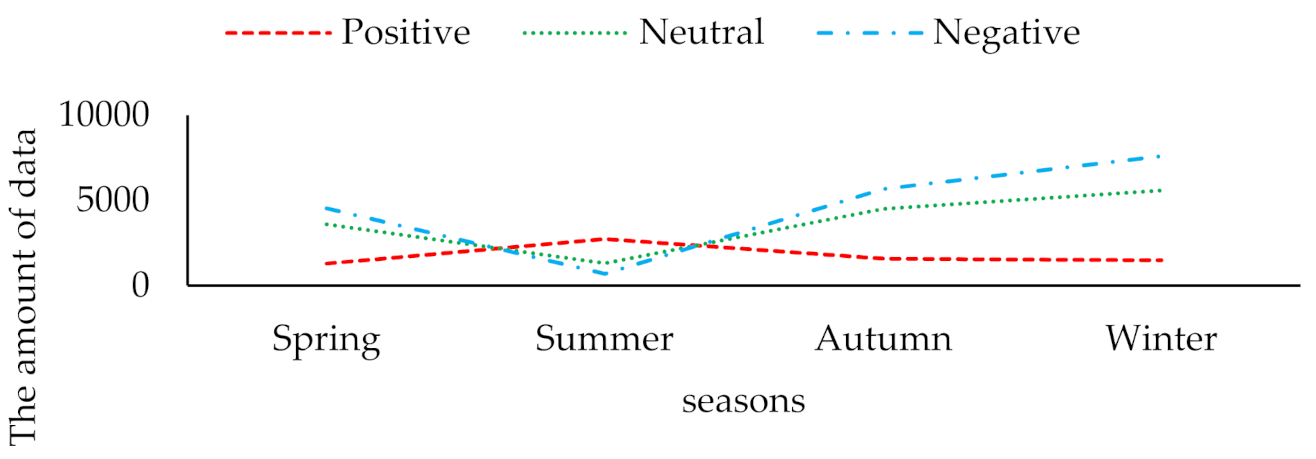
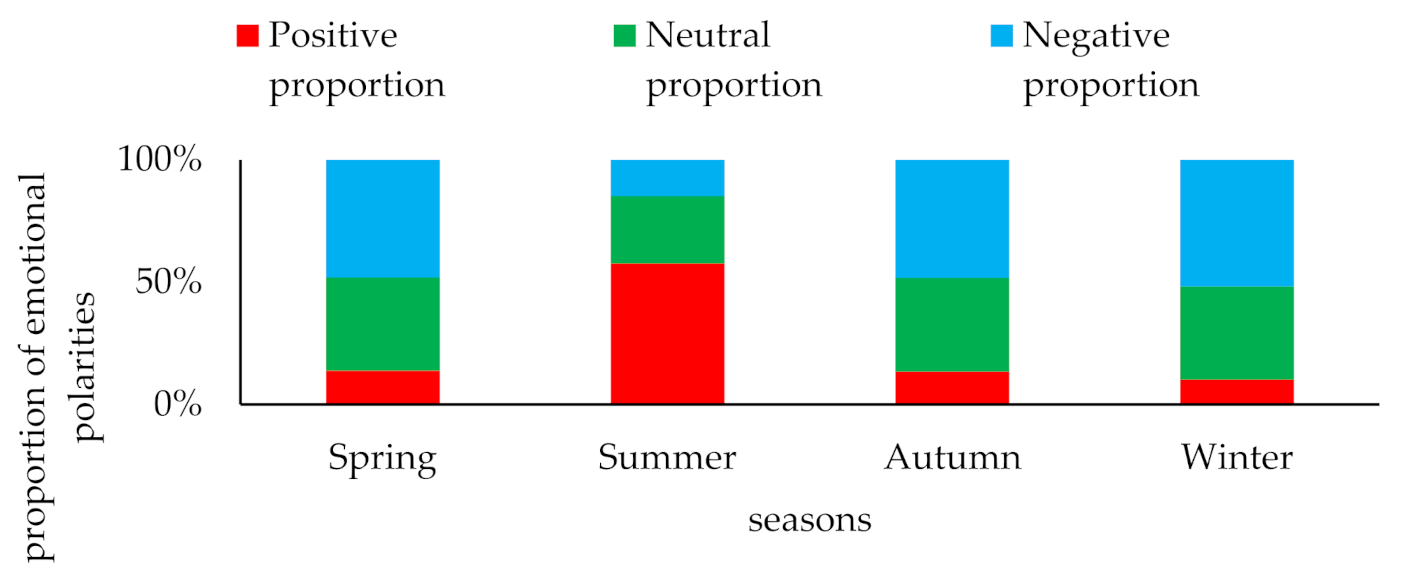
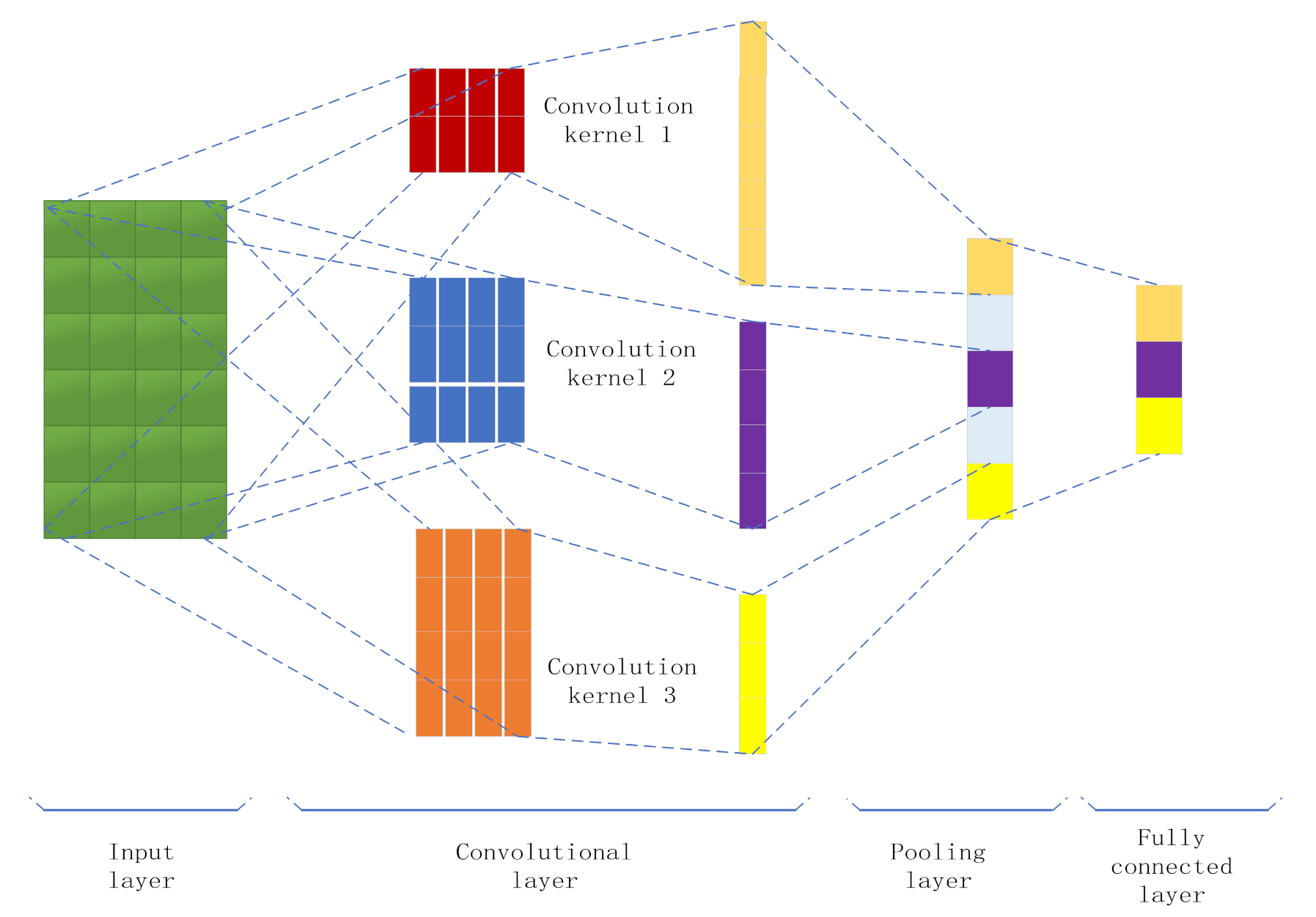
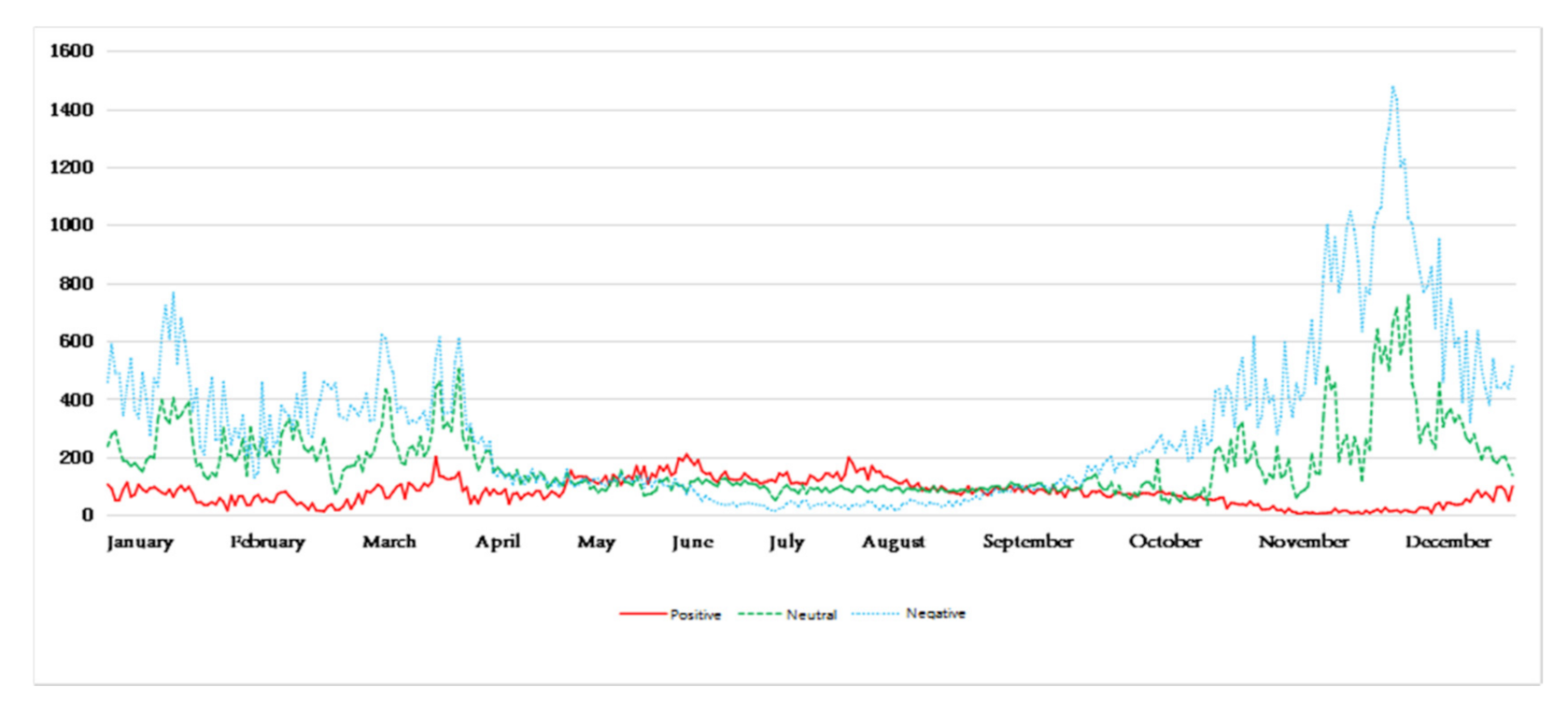
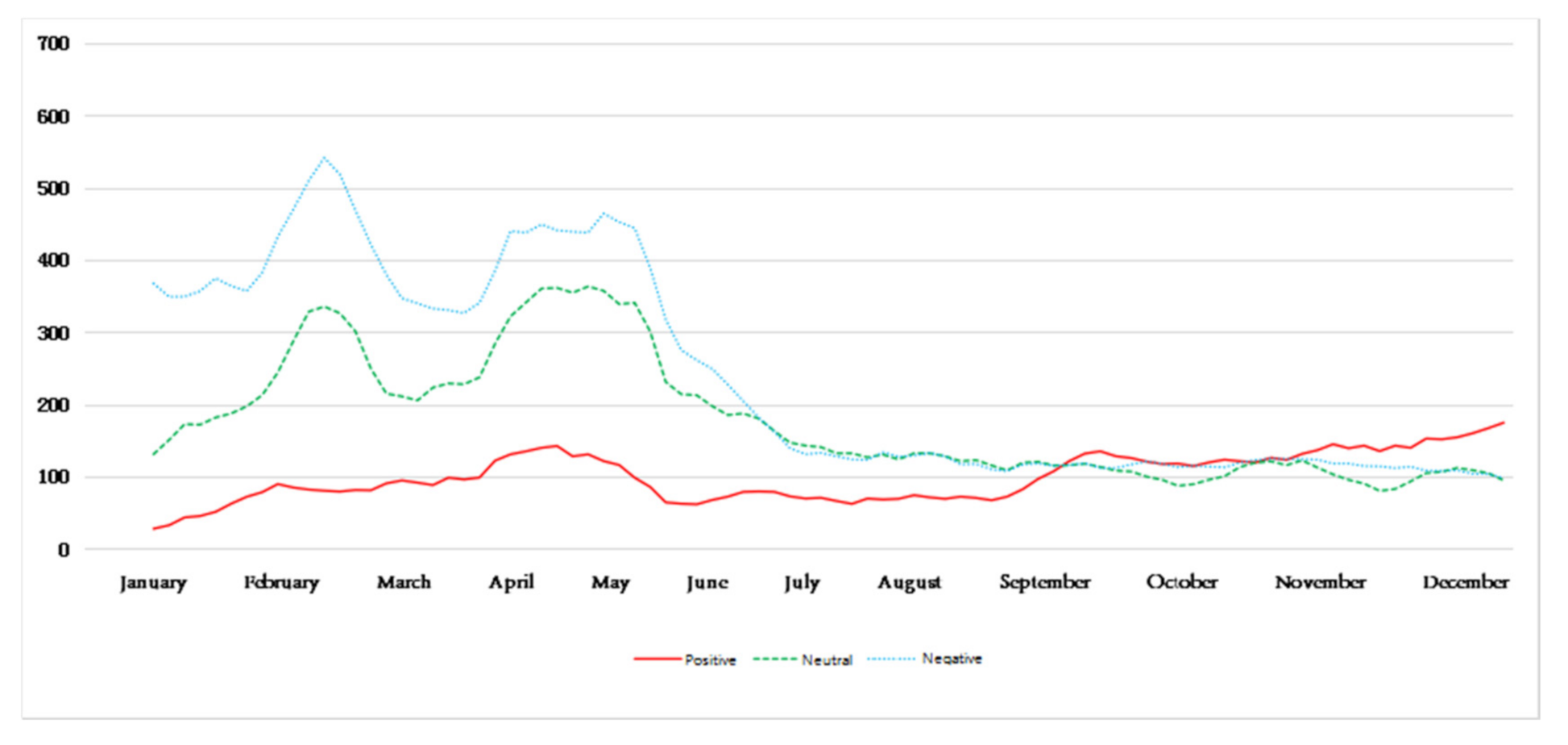
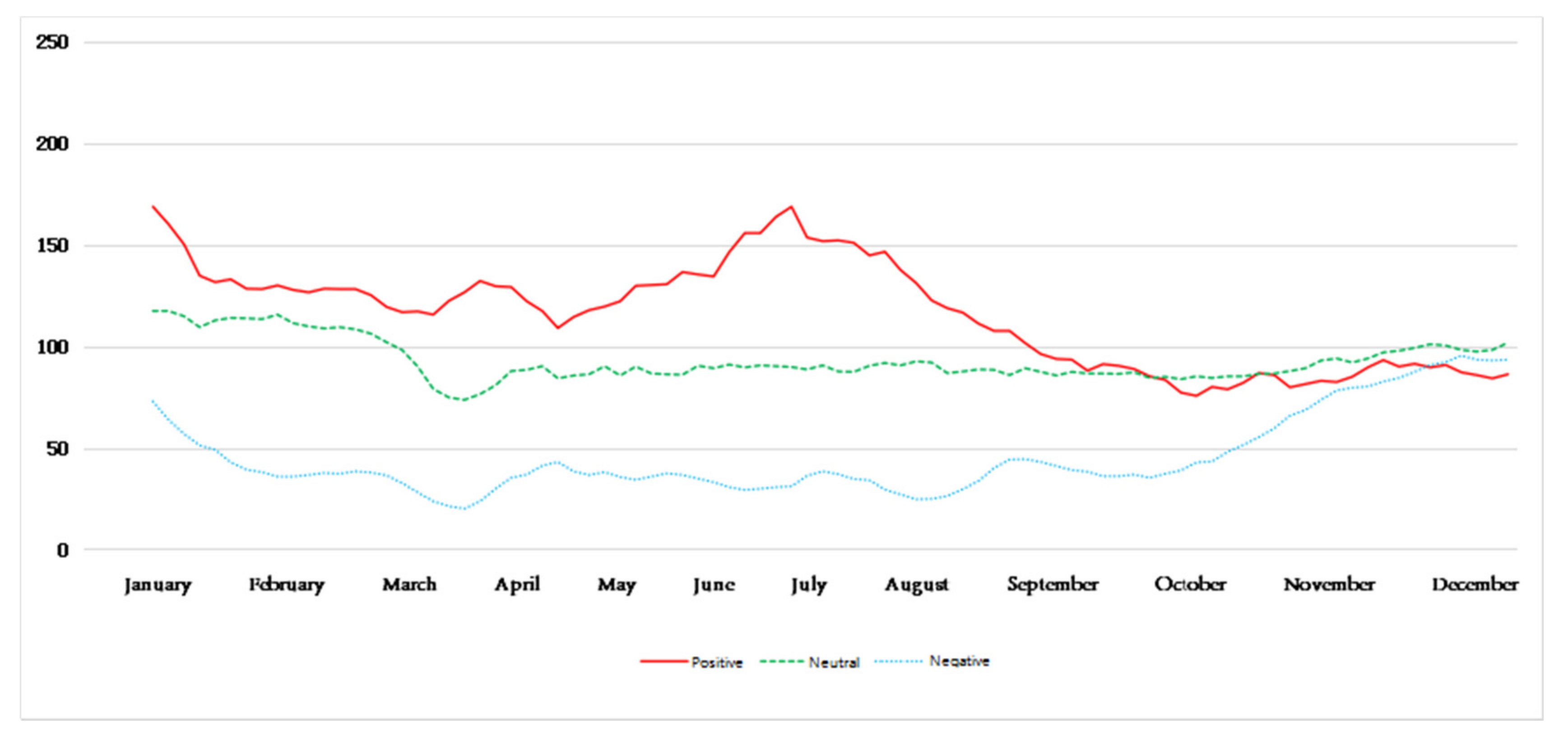
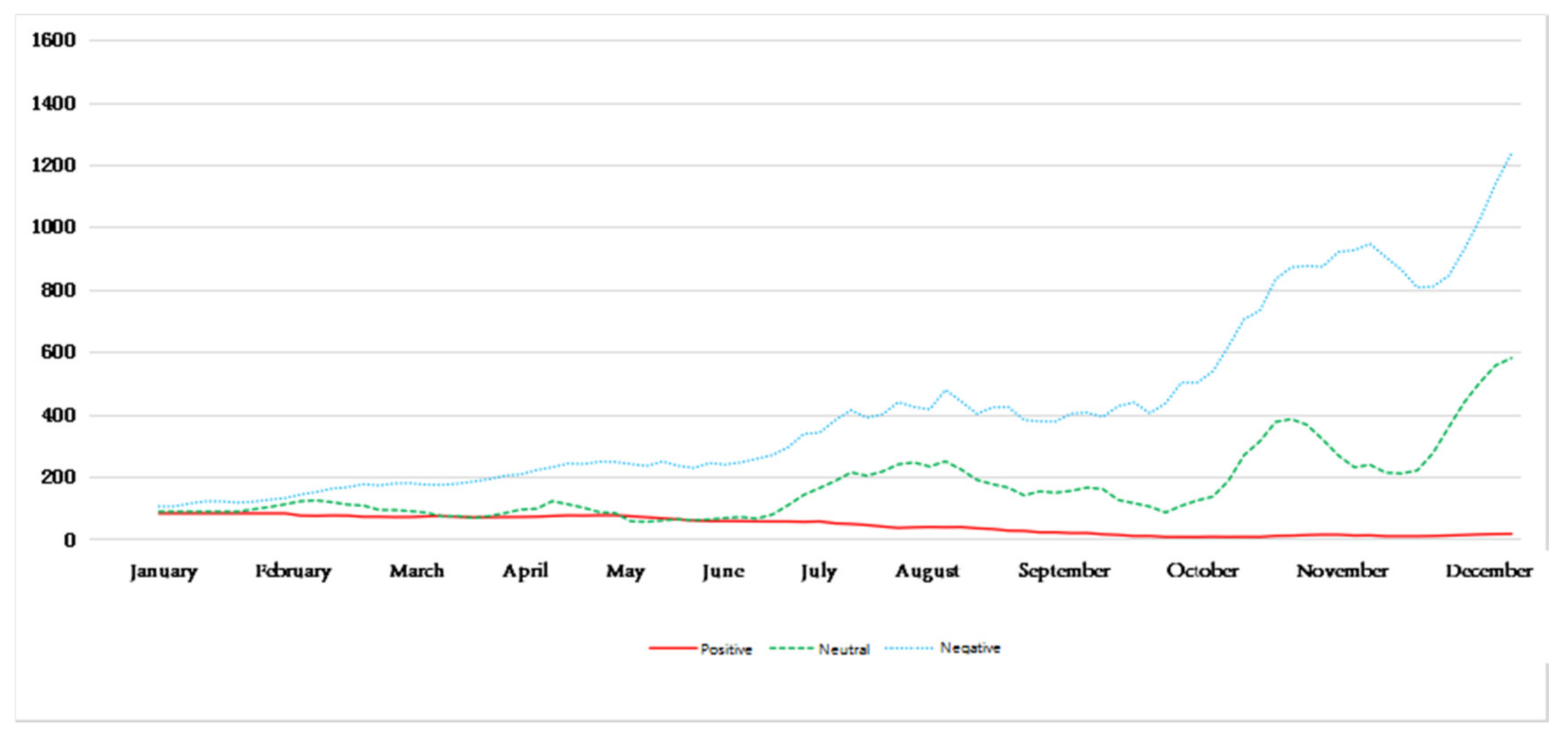

| Positive Example | Counterexample | |
|---|---|---|
| Positive example | Treat positive examples as positive examples (TP) | Treat positive examples as negative examples (FP) |
| Counterexample | Treat negative examples as positive examples (FN) | Treat counterexamples as counterexamples (TN) |
| Total | TPR = TP/(TP+FN) | FPR = FP/(FP+TN) |
| id | MacroP | MacroR | MacroF | MicroP | MicroR | MicroF |
|---|---|---|---|---|---|---|
| 1 | 88.67% | 77.27% | 84.96% | 88.79% | 79.11% | 88.79% |
| 2 | 89.01% | 76.98% | 85.67% | 89.25% | 78.54% | 88.42% |
| 3 | 88.86% | 76.56% | 85.55% | 88.71% | 78.37% | 89.12% |
| 4 | 88.75% | 77.23% | 85.91% | 89.37% | 79.18% | 88.37% |
| 5 | 88.93% | 76.77% | 84.63% | 88.93% | 78.75% | 88.63% |
| 6 | 88.78% | 76.45% | 84.71% | 89.55% | 79.27% | 88.49% |
| Average | 88.84% | 76.88% | 85.24% | 89.10% | 78.87% | 88.64% |
| MacroP | MacroR | MacroF | MicroP | MicroR | MicroF | |
|---|---|---|---|---|---|---|
| SVM | 81.76% | 72.67% | 80.56% | 83.85% | 75.88% | 81.77% |
| CNN | 88.84% | 76.88% | 85.24% | 89.10% | 78.87% | 88.32% |
Publisher’s Note: MDPI stays neutral with regard to jurisdictional claims in published maps and institutional affiliations. |
© 2021 by the authors. Licensee MDPI, Basel, Switzerland. This article is an open access article distributed under the terms and conditions of the Creative Commons Attribution (CC BY) license (https://creativecommons.org/licenses/by/4.0/).
Share and Cite
Bao, Q.; Zhang, X.; Wu, X.; Zhang, Q.; Chen, J. Research on Public Environmental Perception of Emotion, Taking Haze as an Example. Int. J. Environ. Res. Public Health 2021, 18, 12115. https://doi.org/10.3390/ijerph182212115
Bao Q, Zhang X, Wu X, Zhang Q, Chen J. Research on Public Environmental Perception of Emotion, Taking Haze as an Example. International Journal of Environmental Research and Public Health. 2021; 18(22):12115. https://doi.org/10.3390/ijerph182212115
Chicago/Turabian StyleBao, Qiang, Xujuan Zhang, Xijuan Wu, Qiang Zhang, and Jinshou Chen. 2021. "Research on Public Environmental Perception of Emotion, Taking Haze as an Example" International Journal of Environmental Research and Public Health 18, no. 22: 12115. https://doi.org/10.3390/ijerph182212115
APA StyleBao, Q., Zhang, X., Wu, X., Zhang, Q., & Chen, J. (2021). Research on Public Environmental Perception of Emotion, Taking Haze as an Example. International Journal of Environmental Research and Public Health, 18(22), 12115. https://doi.org/10.3390/ijerph182212115





